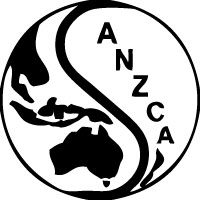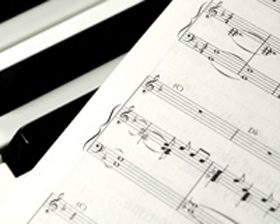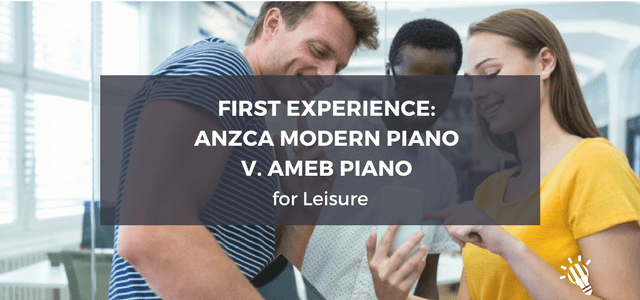
This year for the first time, I chose two students who I felt suited an ANZCA exam : one student studied Grade 2 and another studied Grade 3. Both students were much more suited to pop/modern music than classical and both enjoyed the idea of improvising. Interestingly, both had completed AMEB exams in previous years. I also made contact with an experienced ANZCA teacher in my area and spent time getting to know the main differences and how to prepare students for the Modern Piano syllabus.
My comparison for this article is with the AMEB’s Piano for Leisure (PFL) syllabus which, according to the AMEB literature, is “designed to explore repertoire including well-loved standards from the classics, jazz styles and arrangements of movie themes and popular songs”.
I have decided to compare these syllabi as both are designed by their respective exam boards for students who favour modern music over the classics and who have less time (and/or inclination) to prepare large amounts of technical work and supplementary assessments (ear tests, sight reading, aural tests, etc.)
Both exam boards require the candidate to prepare three pieces, one of which may be free choice. Both exams have less onerous technical work requirements than their “classical” counterparts. While ANZCA requires candidates sitting Grade 6 practical have Grade 3 theory and so on for the higher grades, the AMEB’s PFL course has no theory prerequisites.
While on the topic of theory, it’s important to note that while ANZCA acknowledges Trinity and ABRSM theory courses as comparable (although at different levels – see below), they don’t acknowledge students who have studied AMEB theory. The equivalent to Grade 3 ANZCA Theory is Grade 5 Trinity or ABRSM, meaning that a student sitting Grade 8 ANZCA must have a pass in either Grade 5 ANZCA theory or Grade 7 ABRSM/Trinity!

ANZCA has three exam sessions each year: May/Jun, Aug/Sep, Oct/Nov and exam costs are more-or-less equivalent to the AMEB.
Let’s now consider two more important differences between the exams: their approach to improvisation and choice of pieces.
In the PFL syllabus it states that “There is no provision for assessment of improvisation and no additional credit will be allocated for [it]”, even though the “candidate may improvise if the style of work warrants it”. On the other hand, the ANZCA syllabus is very much focussed on developing improvisation skills by testing it formally as part of the technical work from Grade 4 onwards and by requiring “embellishment” in pieces from Grade 2 onwards (this is a change for 2013).
By Grade 4, the following is required as part of a student’s technical work:
The candidate will be given an 8-bar melodic line with chord symbols above the stave. The candidate will then play this melody with a suitable simple accompaniment pattern of their own choice. An introduction and/or coda may be added, but is not compulsory. The candidate my sight read the melody line (right hand only) before commencing. Harmony: tonic, subdominant, dominant and dominant 7th chords only. Time signatures: 3/4 and 4/4. Major keys: C, G and F. Minor keys: A, E and D.
A student’s ability to do this under exam pressure requires that reading lead sheets, making-up accompaniments and learning about harmony must form a consistent part of a student’s studies during the year. For teachers who believe in the importance of this kind of improvising, and let’s face it: students who are good at improvising are generally better sight readers, composers and group musicians, this will be a welcome addition to an exam. On the other hand, if teaching improvisation, structure, harmony and composition is not a strong point, teachers may prefer to stick with the PFL syllabus.

Of course there is nothing wrong with the choice of pieces available in the PFL syllabus, but it’s an important difference for teachers to note. In my opinion, if you would like your students to be better ‘modern’ pianists with the ability to improvise, compose, play from lead sheets, embellish performances, play in groups, understand chord charts, etc., then you might like to try ANZCA.
If, on the other hand, you’re looking for an exam that is like the AMEB’s ‘classical’ Piano Syllabus but significantly less onerous, more flexible and with some more modern music to choose from, then the PFL syllabus might just be perfect for you and your students. Just don’t expect the pieces to by any technically easier! Given the requirement is for fewer pieces in PFL, most of the pieces are just as technically demanding, in my opinion, as the main Piano Syllabus!
Finally, while we’re talking about ANZCA exams, you may be interested to know that they also offer exams in:
For more details, please head to ANZCA’s website: www.anzca.com.au. For more information about the AMEB, head to: www.ameb.unimelb.vic.edu. Syllabi for each exam may be found by clicking the links at the top of the article.
Enjoy your Christmas break!

Rebecca Stewart, www.sightreading.com.au says:
Kay, I would agree with Tim that in Australia the exam culture is enormous, so much so that many parents expect an AMEB exam every year. You might enjoy reading some articles by Elissa Milne on the exam dilemma: http://elissamilne.wordpress.com/tag/ameb-exams/
Tim, thanks for all your hard work here. The improvisation component sounds similar to what my Yamaha students work on! http://www.yamaha-mf.or.jp/english/grade/pdf/PG07_Syllabus.pdf
Kay Lowry says:
I live in Texas and I find all this Australia exam info very interesting. In our town, most teachers prefer festivals over exams. There is a push in USA to get more teachers involved in national exams. Do you have some students that you feel are not candidates for exams?
timtopham says:
Absolutely! In fact the majority of my students don’t sit exams these days! Do most of your students get involved in festivals and competitions? It’s interesting how different the exam focus is between Australia/UK and USA. Aust and uk seem to do exams while the USA is focused on festivals as the assessment tool. I hear “The Achievement Program” exam system has been gaining some traction – do you use this with your kids?
kaylynnlowry says:
Tim, I can have only lived and taught in Texas and Oklahoma, so I am sure my perspective is limited. From what I read, “The Achievement Program” and the “RACE” examinations are gaining some ground. I have entered students in the Guild Auditions sponsored by the National Guild of Piano Teachers. I stopped doing so several years ago. Main reason- exams are usually during school hours, and schools were counting the absence as unexecused. Parents who work had trouble with the scheduling. Also, preparing for the auditions necessitated three and a half months of review. What I did like about the Guild Auditions was the flexibility in the Syllabus to choose a program that fit each student, but also encouraged growth from year to year. Now, I try for the same teaching objectives, just in differing forms of evaluation. I enter students in festivals, theory tests, and have my own studio competitions for scales, composition, improvisation, etc.
Rebecca, thanks for the links! I am enjoying reading what all of you are doing!
Margaret says:
I have never used ANZCA…perhaps it is time to try something new in 2013. I’ll explore the music on my own first.